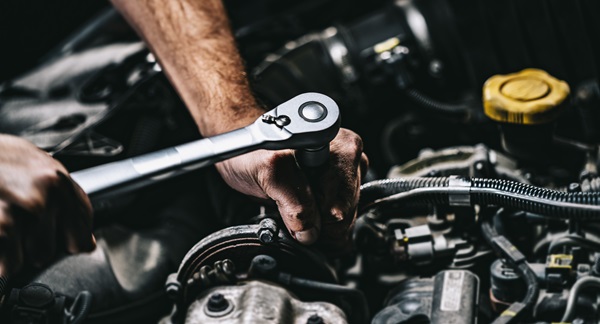
Our Ohio workers’ compensation attorneys can explain your rights and help you take action
Many of us have used the heel of our hand like a tool, pounding or twisting objects without thinking about it. For people who work with heavy equipment or vibrating tools, that habit can lead to hypothenar hammer syndrome (HHS), a rare but serious vascular injury that often leads to time away from work.
HHS occurs when repetitive trauma damages the ulnar artery on the palm side of the hand. Grinding, pushing, or twisting hard objects with the edge of the palm can injure this artery, reducing blood flow to the little and ring fingers. Sometimes a single hard blow may cause enough damage to trigger the syndrome. Symptoms often begin subtly but can progress to chronic pain if untreated.
The hypothenar area is the fleshy part of the palm opposite the thumb. Over time, repeated impacts or vibrations can cause the artery to narrow or clot, cutting off circulation to the fingers. Because early signs are mild, workers may not seek treatment until significant damage has occurred.
Who is most at risk?
Certain professions are more susceptible to HHS. This includes auto mechanics, metal workers, lathe operators, miners, machinists, butchers, bakers, carpenters, and bricklayers, or anyone who relies on the heel of the hand for force. People who use vibrating tools such as jackhammers or chainsaws face similar hazards.
In these jobs, the palm regularly absorbs blows from tools or materials. A mechanic might pound a part into place with the side of the hand, a carpenter may hold a chisel steady with the palm while striking it, and a bricklayer might use the hand to level bricks. Vibration can transfer to the hand and injure blood vessels over months or years.
What are the warning signs?
Symptoms of HHS include pain or tenderness along the edge of the palm, paresthesia (a sensation of pins and needles), numbness in the ring or little finger, difficulty gripping heavy objects, cold sensitivity, and changes in finger color. These signs may come and go, so workers sometimes dismiss them. As the artery narrows, fingers may become consistently cold or discolored, and the pain may worsen. Severe cases can lead to ulcers and tissue damage.
Doctors diagnose HHS by taking a patient’s history and using tests such as Doppler ultrasound to measure blood flow. Early detection is important because treatment is more effective before the artery becomes fully blocked.
How can you prevent HHS?
Although HHS is serious, it is preventable. Workers can protect their hands by adopting a few simple practices:
- Use tools properly: Avoid using your palm as a hammer. When possible, use the appropriate tool for pounding or twisting.
- Wear protective gloves: Padded gloves absorb impact and vibration.
- Choose vibration‑dampening equipment: Many modern tools have built‑in vibration reduction.
- Take breaks: Rotating tasks reduces the cumulative effect of vibration.
- Seek ergonomic training: Learning proper hand positioning and tool grip can prevent unnecessary strain.
- Employers should provide training and proper equipment: Workers should report early symptoms to supervisors and seek medical advice before the condition worsens.
Can HHS be treated?
If caught early, hypothenar hammer syndrome is usually manageable without the need for surgery. Doctors often recommend resting the hand, avoiding further trauma, and using medications to improve blood flow. Physical therapy may help restore circulation. Lifestyle changes such as quitting smoking and managing blood pressure support healing.
When the artery is severely damaged, surgical intervention might be necessary. Surgeons can remove the injured portion of the artery or bypass it using a vein graft. Patients may need to modify work activities during recovery to avoid re‑injury.
Is it a work‑related injury?
Given that HHS arises from repetitive hand trauma, it is often considered a work‑related injury. Workers’ compensation programs provide benefits for injuries that occur in the course of employment. To qualify, employees must show that their job duties significantly contributed to the condition.
In HHS cases, the connection is usually clear. A bricklayer or machinist has far more exposure to hand impact than someone performing office work. When workers develop HHS after years of using heavy tools or experiencing vibration, they typically meet the criteria for workers’ compensation.
Why filing a workers’ comp claim matters
Workers’ compensation benefits can cover medical bills, wage replacement, and rehabilitation. Yet many employees are unsure of their rights or underestimate the benefits available. Claims can be denied if employers argue that the condition is unrelated to work. Filing promptly and documenting relevant duties help support your claim. The process can be complicated. Deadlines vary by state, and paperwork must be completed correctly. Employers and insurance companies sometimes dispute claims to reduce costs. Legal assistance can make a significant difference in securing benefits.
While workers’ compensation is designed to protect injured employees, navigating the system alone is challenging. Injured workers may not be aware that compensation covers more than just immediate medical bills and can also include lost wages and ongoing care. Some benefits (such as coverage for long‑term therapy or vocational rehabilitation) are not always obvious and may require legal advocacy.
Our attorneys at Hochman Plunkett Co., L.P.A. have handled workers’ compensation cases throughout Ohio for decades. Our experience means we understand how complicated the workers’ compensation system is.
During your free consultation, you’ll meet with an attorney who will listen to your story, examine medical records, and guide you through the claims process.
To get started, contact us for a free case evaluation. With offices in Dayton, Cincinnati, Columbus, Springfield, and Troy, we offer legal representation to injured workers statewide.
“Though my case is still in progress, Lisa and Amy have been super helpful and supportive as well as knowledgeable.” – M.C., ⭐⭐⭐⭐⭐
